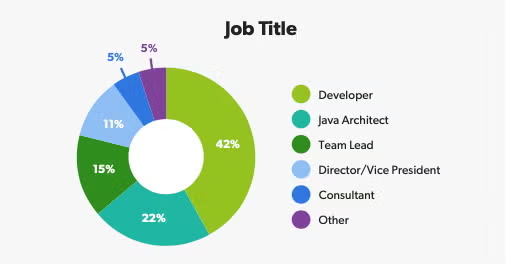Blog
March 13, 2024
Each year, JRebel’s annual Java Developer Productivity Report collates valuable information on the biggest challenges Java developers are facing—and the tools and technologies they’re using to solve those challenges. Now in its 12th edition, this year’s Java Developer Productivity Report certainly meets that lofty bar. While many data points reflect that it’s business as usual for businesses that rely on Java, there are some exciting highlights.
In this post, we outline key findings—and what they mean for your organization. Read on to learn more about:
About This Year’s Survey
We surveyed 440 Java developers, Java architects, Java team leads, and more for this year’s survey. The greatest number of responses came from those on teams of 3-9 developers (29%); that makes sense because most scrum teams cap at nine developers.
This year’s survey not only captures the opinions of Java developers, but also the business leaders who oversee those teams. Of this year’s respondents, 42% were developers, 22% were architects, 15% were team leads, and 11% were directors or vice presidents at their organizations. Company sizes were similarly across the board, with 29% at enterprise companies (1,000+ employees), 22% at mid-sized companies (100-1,000 employees), 14% at small companies (20-100 employees), 18% at statups (up to 20 employees), and 17% as freelancers or contractors.

The 2025 Java Developer Productivity Report Is Here!
Want the latest data? Download your copy of the 2025 Java Developer Productivity Report today.
Upswing for Investments in Java
The biggest theme from this year’s report is that Java is here to stay as the stable backbone of enterprise applications. Clear data points back up that assertion: 60% of companies plan to add Java developers in 2024 while 42% plan to increase their Java development tool budget.
In conjunction, these numbers send a strong message that Java is here to stay as a core part of enterprise applications. The fact that companies are very deeply entrenched with large Java applications will continue to be a driving force for hiring Java developers throughout the developer ecosystem. These are also encouraging trends as economic headwinds have hit other areas of business.
Adoption of Java 21 is Increasing
Long-term support and security go hand in hand, and that’s apparent by the steady adoption of Java 21, which was just released in September 2023. Results were polarized, though. While 11% had already migrated to Java 21, 24% were still on Java 11, which Oracle no longer offers standard support for. That latter point signals that enterprises are turning to third-party vendors like Amazon Corretto, Azul Zulu, and OpenLogic for unsuported JDK versions.
⚙️ Learn more about OpenJDK support.
We expect adoption of Java 21 to increase as Oracle accelerates the frequency of long-term support JDK versions from every 3 years to every 2 years. The burden of upgrading JDKs used to be very large due to large sets of features being released with each subsequent release. Today, many companies realize that it’s much easier to maintain support for the latest version of Java due to a smaller group of features introduced with each release.
The 2024 Java Developer Productivity Survey also asked respondents about their primary reasons for upgrading JDK versions. Overall, long-term support (25%) and security (24%) were top reasons for upgrading, but new features (19%), performance (16%), and compliance (14%) also made the list, with multiple responses possible.
💎 Discover the hidden gems in Java 21 in this on-demand webinar.
IDE Preferences are Shifting
Respondents were also asked to share which Java IDEs they were using. Once again, IntelliJ IDEA topped the charts with 41% of respondents. Eclipse held onto the second position (23%), but Microsoft Visual Studio Code, or VSCode, is close behind at 19%. Additionally, 84% of respondents using IntelliJ IDEA said they use more than one IDE in their Java development practice, with VSCode being the most popular secondary IDE.
📚 Learn more about VSCode.
We look forward to watching adoption of VSCode increase—especially for targeted use cases. And the lightweight code editor space will soon have a new addition: JetBrains Fleet is currently in Beta and is expected for general availability later in 2024.
Looking for More Intel on Java IDEs?
Check out this comprehensive guide. In it, you'll find which Java IDEs are most popular in 2024, how Java IDEs are incorporating AI, and more.
Microservices May Not Be a Universal Answer
A handful of years ago, microservices were billed as a pancea for enterprise applications. After years of trending upward, microservice adoption rates were largely status quo. While more than half of respondents are on microservices, a sizeable portion are using monolith or modular monolith environments.
But this year’s report also revealed that the number of microservices in enterprise applications has ballooned over the past four years, with the number of respondents using 11 or more microservices rising from 16% in 2021 to 41% in 2024.
Cloud Development is Taking Off
According to Gartner, more than 70% of enterprises will use industry cloud platforms to accelerate their business initiatives by 2027. These numbers will likely continue to grow as business needs increase. This is reflected by the 2024 Java Developer Productivity Report, where only 13% of respondents said they don’t use a cloud provider. AWS (31%), Microsoft Azure (18%), and Google Cloud Platform (11%) have a firm lock as the so-called “Big Three” but this year’s survey showed that secondary cloud providers like IBM Cloud and Alibaba Cloud comprise 29% of respondents.
Cloud usage is taking off, and so are startup times. 43% of respondents have seen their startup times for remote containerized environments increase by 10% or more.
Final Thoughts
Want to keep the productivity trends rolling? Try JRebel. By eliminating redeploys, you could save a month of Java development time annually.
Want to see how much time you could save by eliminating redeploys? See for yourself during your 14-day free trial of JRebel.
